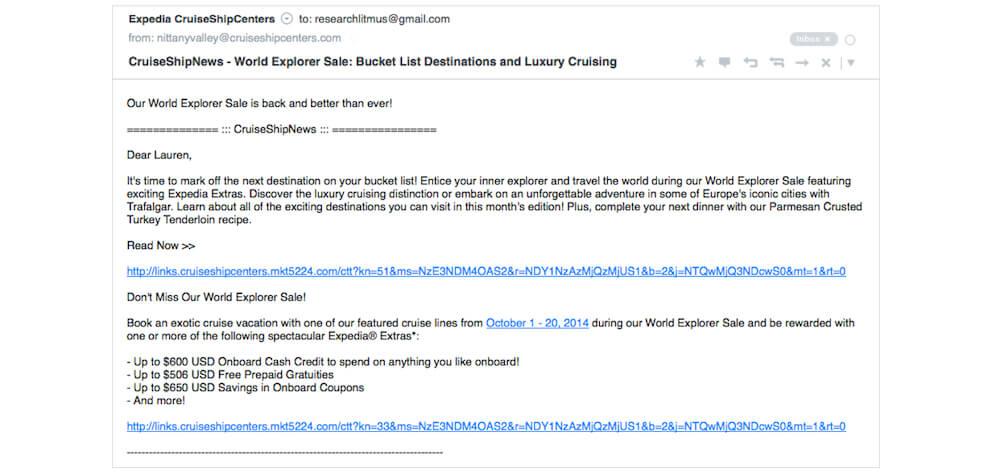|
Getting your Trinity Audio player ready...
|
Are you struggling to grow your B2B business? Despite having a great product or service, do you find it hard to reach your target audience and generate leads? The solution may lie in your marketing strategy.
Business-to-business (B2B) marketing is different from business-to-consumer (B2C) marketing. B2B marketing targets other businesses and organizations as customers, which requires a different approach. However, many businesses do not understand the intricacies of B2B marketing, which can hinder their growth.
To succeed in B2B marketing, you need to have a clear strategy that aligns with your business goals. This strategy should include tactics that help you reach your target audience, generate leads, and convert them into customers.
In this article, we will discuss some effective B2B marketing strategies that can help you grow your business.
B2B Marketing
B2B marketing is the practice of promoting products or services from one business to another through targeted messaging and strategic campaigns.
What is B2B Marketing?
B2B marketing consists of the series of strategies and techniques used by a firm to effectively reach, nurture and sell their products and services to other businesses. In B2B marketing, the buyers are often C-suite or director-level professionals at other companies. Therefore, B2B marketing is different from other kinds of marketing.
One key difference when businesses buy from other businesses is that there is often a longer sales cycle. Buyers are looking for solutions that solve complex challenges related to their businesses.
So effective B2B marketing is challenged with providing relevant, helpful and persuasive content that attracts the attention of buyers at all stages of possible interest. Let’s explore how this looks practically with some examples.
B2B Marketing Examples
We simplify the concept of B2B marketing by thinking of it as a three-tiered funnel. In this section, we’ll explain each tier and provide examples of how B2B marketing techniques fit into the mix.
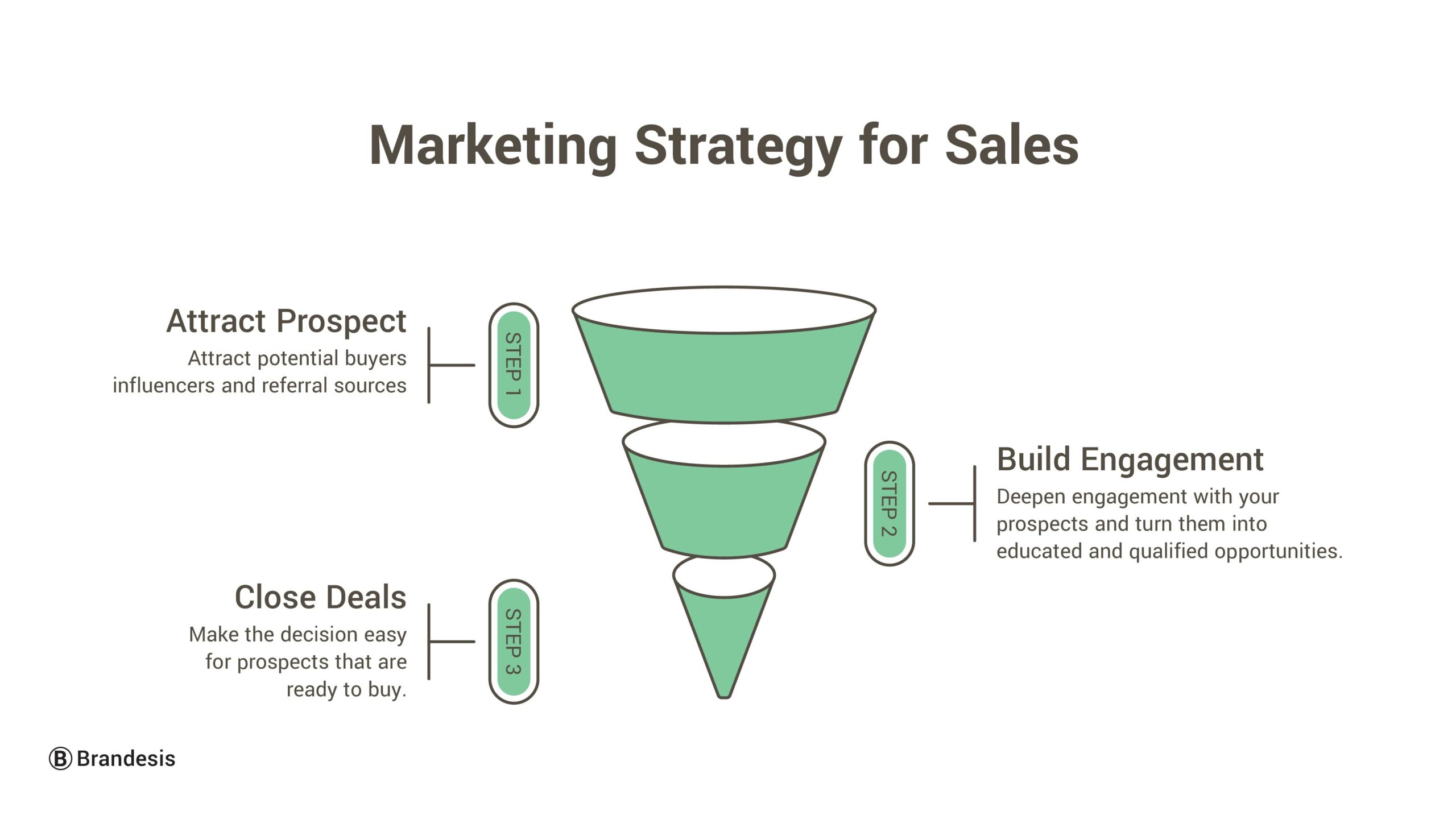
At the top tier of the marketing funnel, you have a potential universe of buyers who are generally unaware of your product and service offerings. B2B marketing activity at this top tier employs techniques that broaden the visibility of your brand and attract the right kind of leads to engage further with your brand.
These leads could be potential buyers, referral sources, or other influencers who could amplify your visibility.
An example of B2B marketing at the top of the funnel might be an expert from your firm who attends, networks at, and speaks at a top industry conference where your firm’s potential buyers gather. Another example would be to submit a series of articles to an online publication that’s widely read by your target audience.
Remember, the goal of B2B marketing at the top of the funnel is not to start closing deals! The objective is to increase your visibility and provide a pathway for leads to take the next step of engagement.
Speaking of engaging your potential buyers, that is what the middle tier of the B2B marketing funnel is all about! If there is one section of the funnel that is underutilized, it’s this one. There is a temptation for marketers to rush potential buyers into a sales pitch. But not all buyers are ready to make a purchasing decision today—some require months or even years before they’re positioned to act.
So the middle of the funnel is where B2B marketers focus on nurturing and engaging their audience over a sustained period.
Examples of middle-funnel B2B marketing usually provide insightful and helpful resources to potential buyers. Webinars are a great example of middle-of-the-funnel B2B marketing. In a live webinar, a potential buyer is allowed to engage directly with your firm’s leading experts in a no-pressure environment where they can learn and ask questions.
The buyer gets to experience your expertise and it’s usually easy to take the next step if they are ready and speak to someone on your team.
Finally, a buyer reaches the bottom of the B2B marketing funnel when they raise their hand and indicate that they are ready to speak with a representative from your firm about one or more of your solutions.
We consider this moment a true B2B marketing lead. At this stage of the funnel, B2B marketers are responsible for preparing those who close business deals in their organization with the materials they need to effectively communicate with the buyer.
Now that we’ve defined what B2B marketing is and how a B2B marketer needs to consider all three tiers of the funnel, let’s explore the ten essential B2B marketing strategies you can implement to help your firm get ahead of the competition.
1. Research
Research is an essential component of modern marketing efforts. It provides a solid foundation for making informed decisions, whether it is conducting marketplace research or brand research.
Detailed scientific studies enable marketers to have an objective basis for their marketing efforts and provide valuable baselines for measuring results.
By conducting research, marketers can understand their clients better, putting them in a better position to serve them. The market research also provides insight into how processes are performing. It can help identify the aspects of a business that are performing successfully and provide a better understanding of the services that should be offered.
The impact of research on a business is significant. Studies have shown that firms that conduct systematic research on their prospects and clients grow three to ten times faster and are up to two times more profitable than peers that do not pursue research.
Therefore, investing in research is critical for businesses looking to gain a competitive advantage in their industry.
2. Niche-driven Strategy
Having specialization and niche targeting is a crucial aspect of any business strategy. Research has shown that the fastest-growing firms tend to be specialists in a carefully targeted niche. This niche should be an area of the industry that you understand thoroughly, enabling you to become an undisputable expert and leader in that particular field.
By specializing in a particular niche, all of your marketing efforts become easier, as it clearly defines what you do and immediately sets you apart from the competition. This specialization also serves as a differentiator that proves your expertise in a particular field.
It’s important to note that specialization should not be confused with limiting your services. Rather, it should serve as a starting point to build a strong foundation for your business.
As you grow, you can expand your services while maintaining your specialization, making it easier to target a broader market without losing focus on your core area of expertise.
A niche-driven strategy can be highly effective, especially in crowded markets where differentiation is crucial. It allows you to stand out in a crowded marketplace, making it easier for potential clients to find you and identify your unique selling proposition.
3. A High-Performance Website
In today’s professional services marketplace, having a high-performance website is essential. Your website serves as the hub of your online presence and is critical for building visibility.
Potential clients search online to find service providers, and they need to be able to find your website for you to have a chance at winning their business.
Moreover, your website enables you to showcase your firm’s expertise and become well-known throughout the marketplace.
According to Hinge Marketing research, 80% of people look at a website when checking out service providers, making it a crucial asset for firms. As new visitors reach your site, you can use robust educational content and targeted offers to drive leads to closer engagements and ultimately bring qualified leads straight to you.
This process of nurturing leads through content is illustrated in the funnel graphic we’ve already discussed earlier in this article.
Design is another critical component of your website that should not be overlooked. Web and graphic design can influence your audience’s perceptions, aid recall, and quickly differentiate a business.
The power of design to engage audiences is often underappreciated, which means it offers a tremendous opportunity to set firms apart and convey the credibility they need to thrive.
Lastly, you need to consider the usability of your website across a wide range of devices, including mobile. Responsive design, which allows your website to adapt to suit a user’s device, has become a key feature as more people use mobile devices to do business.
By ensuring your website is accessible on all devices, you make it easier for potential clients to find and engage with your firm, ultimately driving more business.
4. Search Engine Optimization (SEO)
Effective online marketing requires that your target audience can find your website, which is where search engine optimization (SEO) plays a vital role.
Research has shown that high-growth firms consider SEO a very effective digital marketing technique. We also found that higher levels of SEO maturity correlate with a greater proportion of digital leads and increased profitability, likely because digital leads cost less to generate.
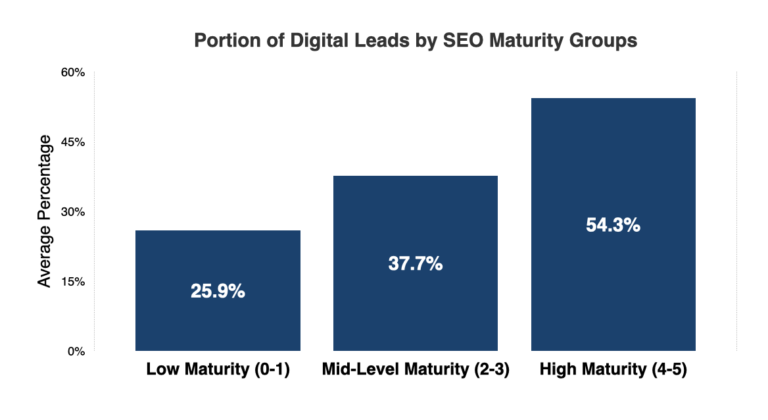
SEO consists of two primary components: on-site SEO and off-site SEO.
On-site SEO uses targeted keyword phrases to communicate the concepts on your site that matter to your audience, typically focusing on your services and expertise. Its purpose is to inform search engines about the content of your website so that they can produce more relevant results for searchers.
Off-site SEO, on the other hand, takes the form of links to your website from high authority and relevant websites, such as through outside engagement or guest articles in other publications.
These efforts aim to increase your site’s authority as a widely recognized leader in your field. As search engines see your site as more credible, your rankings will improve.
With SEO, your website will be more likely to show up in relevant searches, making it easier for potential clients to find you. By investing in both on-site and off-site SEO, you can increase your website’s visibility, generate more leads, and ultimately drive more business growth.
5. Social Media
Social media has become a crucial aspect of marketing for professional services firms. Research has shown that over 60% of buyers use social media to check out new service providers, making it a more popular source of information than formal referrals and recommendations.
Furthermore, social media has transformed the nature of referrals. According to a recent study, 17% of expertise-based referrals are made based on interactions on social media. This means that social media can amplify the reach of your reputation, expertise, and content, and help you connect with valuable contacts and influencers.
Social media also offers the opportunity to monitor your brand through social listening, which involves tracking online conversations and mentions of your firm to identify and respond to potential issues or opportunities.
However, it’s important to note that social media can also be overwhelming and time-consuming. It’s essential to have a clear strategy in place and to focus on the platforms that are most relevant to your target audience.
By doing so, you can effectively use social media to enhance your firm’s visibility, reputation, and engagement.
6. Advertising
Effective advertising is a crucial component of successful digital marketing for professional services firms. There are several platforms available for advertising, including:
- Industry publications
- Websites
- Social media
- Search engine marketing (SEM)
- Retargeting
Advertising not only promotes services but also drives content downloads, increasing expertise and visibility. However, it is essential to use forms of advertising that are best suited to your business.
LinkedIn, retargeting and other industry-focused advertising are ideal as they allow the targeting of appropriate industry audiences directly, resulting in higher conversion rates, click-through rates, and lower costs per download.
In contrast, SEM can be expensive and difficult to target for professional services purposes.
Similarly, Facebook ads are usually less effective as the platform is not commonly used by professional service buyers compared to other social media networks.
Nevertheless, it is important to consider that each of these advertising types has many variations, and their success may depend on budget, ad purpose, targeting, and industry niche.
Ultimately, it is crucial to select the most appropriate platform for your advertising strategy to get the best results for your professional services firm.
7. Referral Marketing
Referral marketing is an essential component of a successful B2B marketing strategy for professional service firms. Over 81.5% of providers have received a referral from someone who was not a client, and these referrals typically come from a firm’s reputation for specific expertise.
To build a brand with a widespread reputation for speciality in your area, it is important to use content marketing in conjunction with other tactics. By doing so, you can establish your expertise and understanding of your audience’s needs, even among those who have not worked with you directly.
This recognition can lead to more referrals and new business opportunities. It is worth noting that referrals are no longer limited to formal recommendations, as social media has changed the nature of referrals.
Therefore, it is important to have a strong presence on social media and use it as an accelerator for the reach of your reputation, expertise, and content. By doing so, you can connect with valuable contacts and influencers and monitor your brand through social listening.
8. Marketing Automation, CRM, and Lead Nurturing
Marketing automation, CRM, and lead nurturing are essential components of a successful B2B marketing strategy.
Marketing automation: Marketing automation replaces repetitive manual processes with automated ones, bringing together all of your online marketing channels into one centralized system for creating, managing, and measuring programs and campaigns.
However, it’s important to select the right marketing automation software that matches your firm’s size, complexity, and scalability needs.
CRM: A Customer Relationship Management System (CRM) is also necessary for tracking and organizing opportunities and client information. This serves as the database for all the information collected about opportunities and clients, including specific interactions with them.
The information can be entered, stored, and accessed by employees in different firm departments, synchronizing efforts across your firm.
Lead Nurturing: CRM is just the beginning. Lead nurturing, which involves guiding a lead through the entire buying process, is another important aspect of B2B marketing. Email marketing campaigns enable you to deliver targeted, analytics-driven offers for specific buyer roles, tailored to their particular place in the buying process.
Drip email campaigns allow you to send more targeted offers to segments of your audience over time, building closer engagement and educating further through successive relevant content and offers.
In short, marketing automation, CRM, and lead nurturing work together to provide a comprehensive marketing strategy that can help your firm succeed in the B2B marketplace.
9. Testing and Optimization
Testing and optimization are important steps in a scientific marketing approach. These allow you to continually improve your marketing efforts and make data-driven decisions instead of relying on intuition.
Just like research, testing and optimization are critical to your marketing strategy. You should never stop testing your campaigns and adjusting them accordingly. There are different ways to do this, such as:
- A/B testing of emails and landing pages: You can use A/B testing tools like Optimizely or Unbounce to determine which of two emails or landing pages is more effective in converting users based on differences in language, design, or other elements.
- Email and landing page rendering: You can use tools like Email on Acid to test how emails will look and function on different devices and platforms, ensuring that they render properly.
By continuously testing and optimizing your marketing campaigns, you can improve their effectiveness and achieve better results.
10. Analytics and Reporting
Effective analysis and reporting are essential components of any successful marketing campaign. To measure results effectively, it is critical to analyze the right metrics. This requires having tools in place to collect accurate data on all your marketing efforts, from your website to social media to SEO.
Google Analytics is an essential tool for measuring and analyzing your site traffic. It provides a wealth of data and insights, such as the number of visitors, page views, bounce rate, and time spent on your website.
MOZ can help you study and improve your SEO results by providing analytics on keywords, rankings, and backlinks.
Similarly, social media analytics tools like Hootsuite can provide detailed information on engagement rates, click-through rates, and follower growth. By monitoring these metrics, you can determine what is working well and where improvements are needed.
Analytics and testing enable you to truly understand what is working and what is not. Embrace these tools and use them to your advantage. They will help you turn your marketing efforts from an art form into a science, allowing you to make data-driven decisions and continuously improve your marketing strategy.
11. Supplement your automation with AI
Marketing automation and artificial intelligence are not identical. Marketing automation software helps humans with simple and repetitive tasks. It still requires configuring workflows for different scenarios and using data for manual optimizations.
AI, on the other hand, mimics human intelligence and reasoning using data. It predicts, suggests optimizations, and applies them dynamically.
The combination of automation and artificial intelligence provides both efficiency and the ability to make data-driven recommendations and adjustments.
The following are instances of how AI can enhance automation:
- Tools for personalized email subject lines and automation within your platform.
- Use Smart Bidding or Insights in Google Ads.
- Using past data for better lead scoring in a CRM.
- Let’s apply the themes to popular B2B marketing channels: SEO, PPC, social media, and email.
12. Employ dynamic content for personalized experiences
Personalization is key in B2B marketing. In fact, according to Demand Base’s latest B2B Buyer Behavior Survey, 70% of buyers ranked relevant content that speaks directly to their company as “very important.”
However, it’s not always feasible to cater your website to each specific company. This is where dynamic content comes in.
Dynamic content can be used on your website to provide a more personalized experience for visitors.
For instance, you can create different live chat options on certain pages based on the channel visitors came from, such as an email or an ad. Additionally, you can use Drift’s integration with Clearbit to obtain even more personalized data.
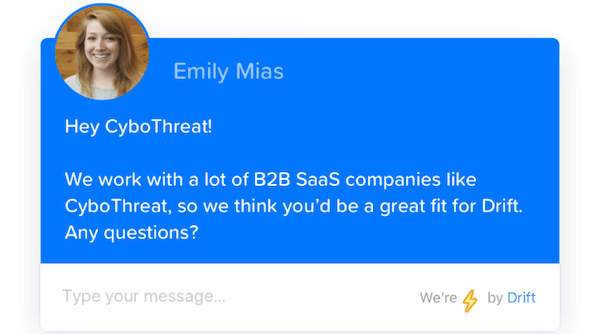
Pop-ups are another effective way to use dynamic content. You can create pop-ups for guides of varying topics based on the category of the blog post visitors are reading.
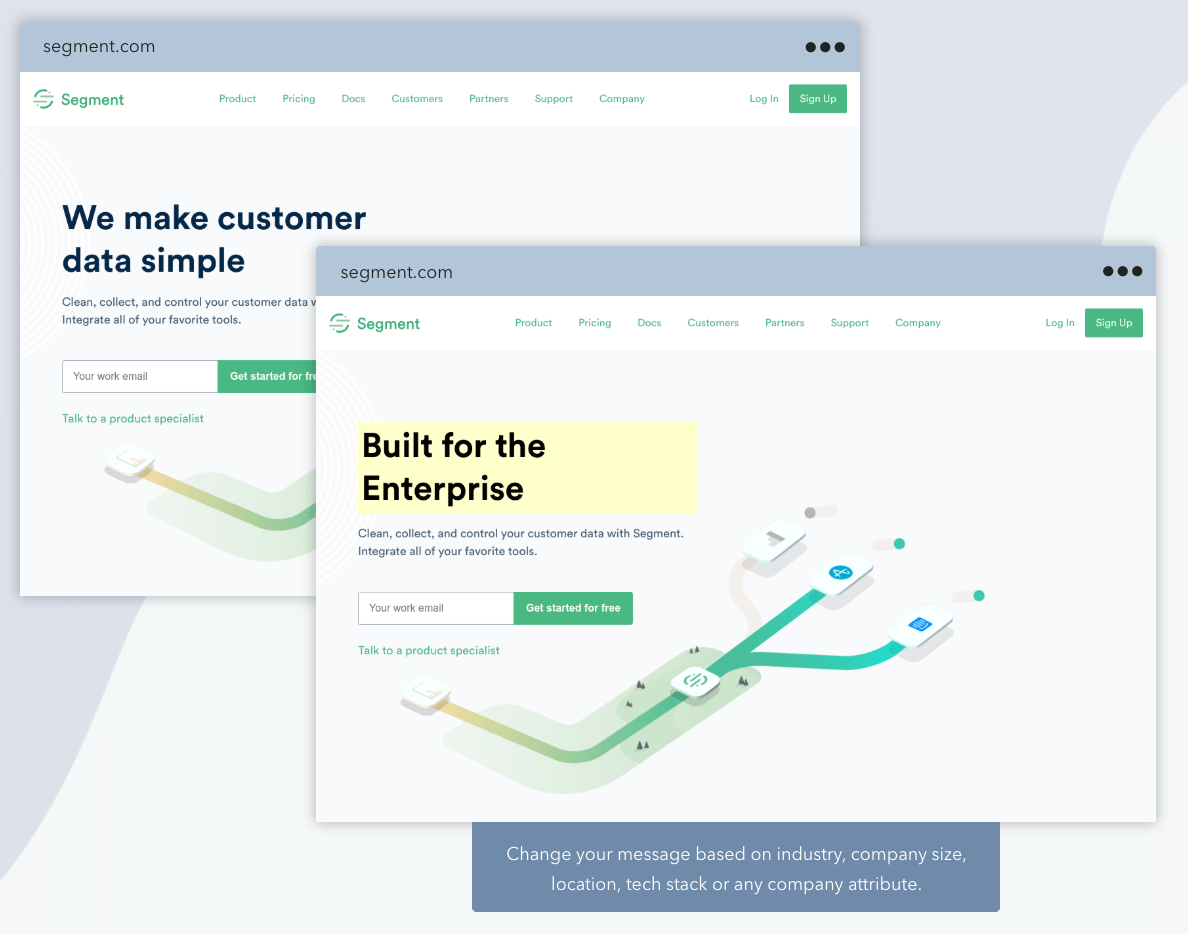
You could even adjust the headline for your homepage based on company size. By creating a pop-up that asks for information to help guide B2B buyers on a path tailored to their needs, you can further personalize the experience.
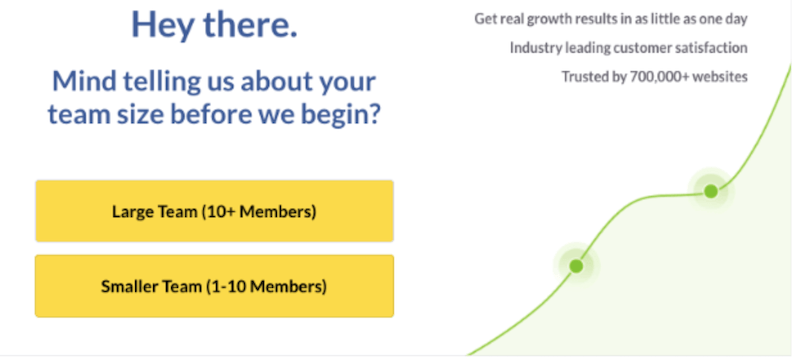
Other criteria for dynamic content include:
- Stage in the sales funnel or customer lifecycle.
- Geolocation (such as offering discounts on tickets to nearby conferences).
- Referral source (SERP, social media, email).
- Website behaviour (new or returning visitor, time on site, pages visited).
Using dynamic content can create a more personalized experience for visitors, ultimately increasing engagement and conversions. Automation tools can be used to ensure that each visitor receives the content and experience that’s most relevant to them.
13. Run nurture campaigns
While many people use drip and nurture campaigns interchangeably, it’s important to note that they are not the same. Drip campaigns are like a series of predetermined, time-based emails that you send out to a specific segment of your list, often to drive conversion.
Nurture campaigns, on the other hand, are based on behaviour. They go out to recipients based on how they have interacted with your site and previous emails. Nurture campaigns are particularly useful in B2B marketing because they focus on educating prospects as they engage with your brand, offering personalized content to help build a stronger relationship.
Take Moz, for example. After creating an account to use their Chrome extension, a user received a nurture email that included a helpful guide.
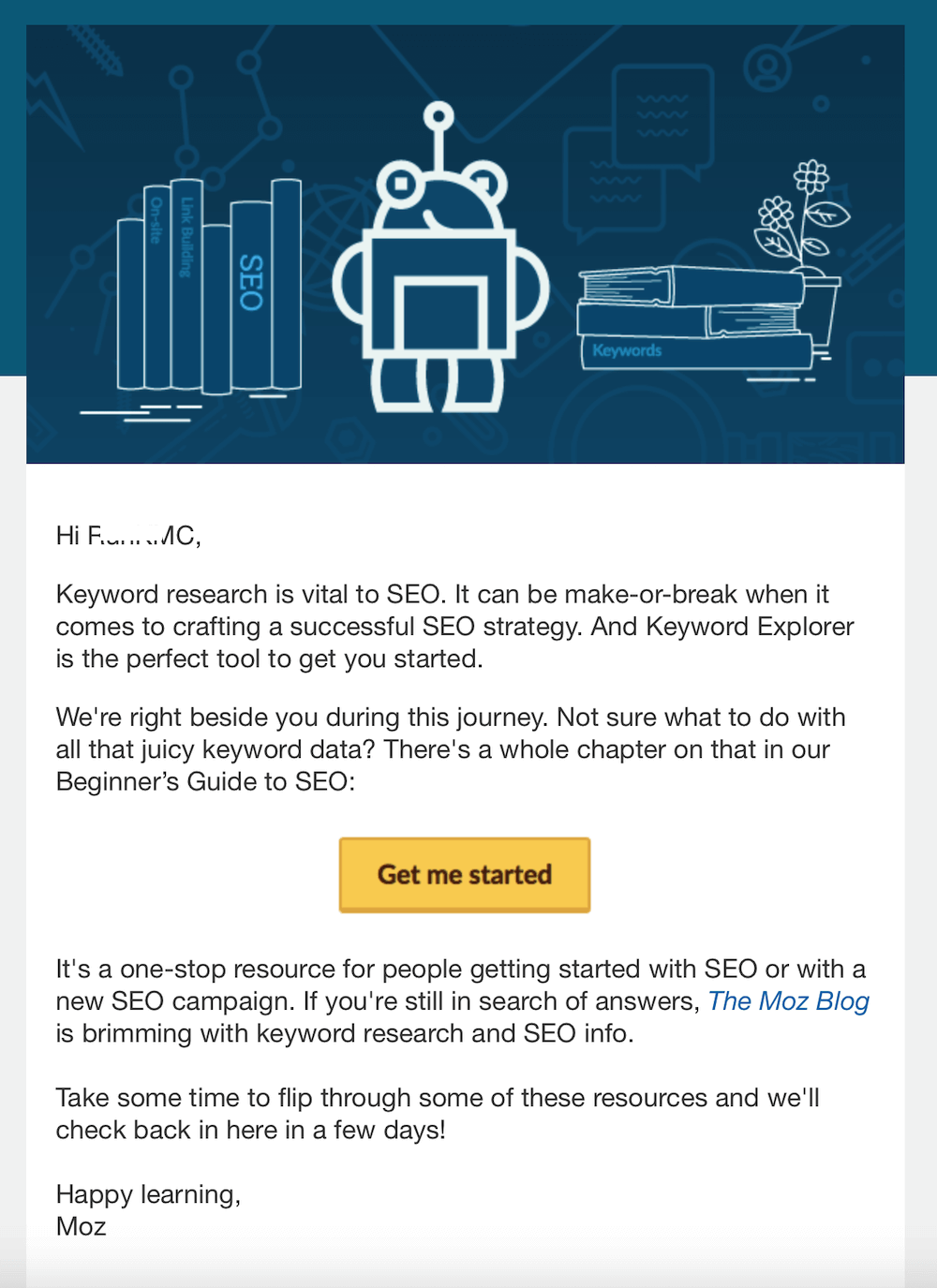
Now, the next email from Moz will depend on whether or not they click on that guide.
14. Increase click-through rates with video emails
Video marketing has been a rising star for about five years now, while email marketing has been a staple for much longer. So why not combine the two for an even more effective strategy? The combination of video and email can increase click-through rates by up to 300%.
Using video in your emails can serve multiple purposes, such as providing a teaser for the content you want readers to click on, showcasing new products or features, revealing your company culture, or even as part of a tutorial series for nurturing leads.
Wistia provides a great example of how to use video in an email:
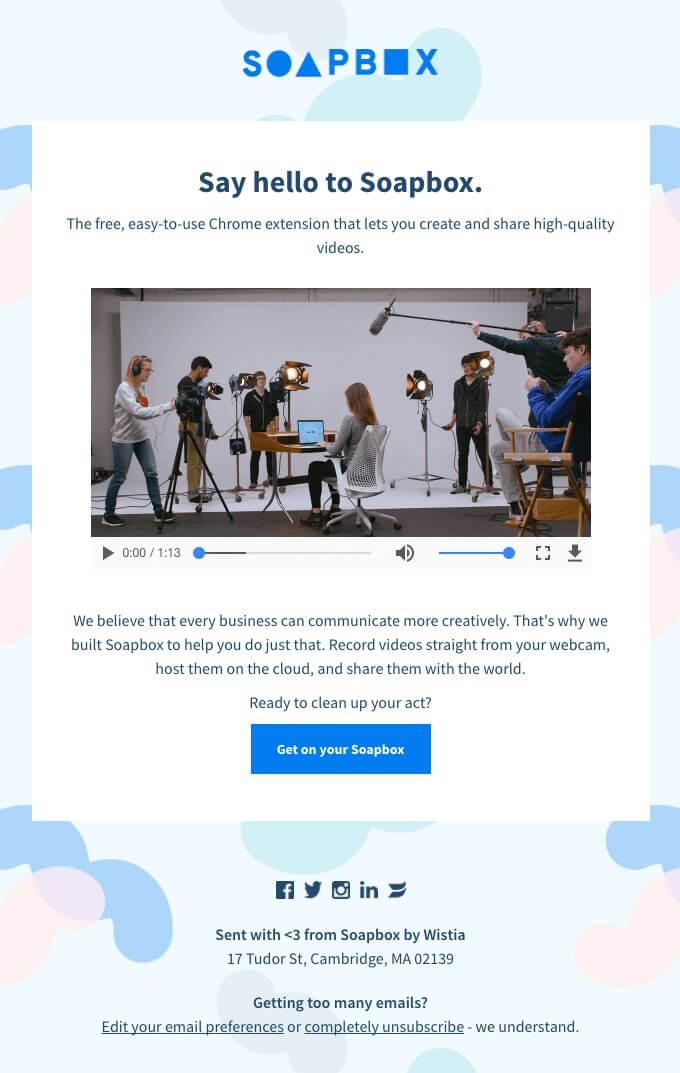
By incorporating video into your email marketing strategy, you can not only increase click-through rates but also engage your audience more dynamically. Just make sure to keep the video brief, attention-grabbing, and relevant to your audience’s interests and needs.
15. Make sure your emails have plain text alternatives
When it comes to sending emails, it’s important to consider the needs of all your recipients. Even if you’re sending HTML emails with visually appealing designs and images, it’s crucial to also include a plain text version.
This not only helps ensure that your emails make it past spam filters, security measures, and privacy settings, but it also ensures that your emails are compatible with a wider range of devices, such as smartwatches and voice-assisted technology.
To make the process of creating optimized plain-text emails easier, Litmus has put together a comprehensive guide that walks you through the necessary steps. By taking this extra step to accommodate all your subscribers, you can improve the accessibility of your emails and provide a better experience for all recipients.
Surprisingly, some readers prefer plain text emails over HTML emails, so it’s important to keep this in mind when creating your email marketing campaigns. By providing both options, you can appeal to a wider range of subscribers and ensure that everyone can engage with your content in the way that suits them best.
